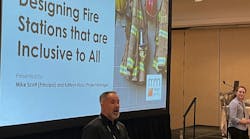Anaheim, CA — Value engineering is an often-misunderstood concept in architecture, but it is a critical component of any station design project. This was the key message from David J. Pacheco, AIA, NCARB, and co-owner of Pacheco Ross Architects, PC, who spoke about value engineering during a Firehouse Station Design Conference pre-conference session last week in Anaheim, CA. Pacheco set out to clarify what value engineering is and is not, noting that “for as long as there has been architecture, there has been value engineering.”
So what is value engineering as it relates to design and architecture? It starts with the acknowledgement that every project has a budget—a budget that must be taken into account at each stage of the design and construction process. In short, value engineering is about finding the appropriate balance between the minimum cost and the maximum quality for a project. As such, architects and the fire personnel working on a fire station must consider a variety of factors and how they affect this balance—factors like the initial project price, overall scope of the project, life cycle costs and minimum time to get the job done. Of course, Pacheco reminded, value is subjective, so the process of determining where to focus resources is not always obvious, but there are best practices for making smart choices.
One of the key misconceptions about value engineering is that it is simply cost-cutting, Pacheco said. “Value engineering is NOT cost-cutting. That can be a component, but it’s really about making optimized decisions,” he said, adding that it’s less about cutting costs and more about bringing maximized value to the project. With this in mind, Pacheco then offered some common strategies for value engineering related to three key areas: 1) architectural fees/scope; 2) design; and 3) construction.
As it relates to the architectural fees and project scope, Pacheco presented the following value engineering tips:
- Carefully define the scope of service.
- Break up scope into phases that create value for the project.
- Educate others to show the project’s value, as it’s important to elicit buy-in from those involved.
- Contract only for what you need.
- Focus on the overall value rather than the initial fee.
- Keep in mind that you cannot lower fees without removing services.
One of the most important elements of the architectural fees relates to selecting the right architect for the job—a selection that is based on qualifications, not cost. Pacheco equated selecting the right architect to selecting the right heart surgeon. “If you had a heart problem, you would select the doctor who is best equipped to fix your problem—not the one who can do the job the cheapest,” he said. This idea is so important that there are even laws and regulations to support it. For example, the Brooks Act of 1972—also known as the “Selection of Architects and Engineers” statute—is a federal law that requires the federal government to select engineering and architecture firms based on competency, qualifications and experience rather than by price. Further, according to the Texas Professional Services Procurement Act (PSPA) – HB76, “The selection of architects, and professional engineers on the basis of the lowest bid places a premium on incompetence and is the most likely procedure for selecting the least able or qualified and most incompetent practitioner.”
In short, Pacheco noted, selecting the right architect is value engineering, because the end result is a higher quality product managed by a team that knows how to manage costs. He supported this by sharing that a study by the Georgia Institute of Technology and the University of Colorado found that qualifications-based selection “consistently meant lower overall construction costs, reduced change orders, better project results and more highly satisfied owners than in other procurement methods.”
When it comes to value engineering in design, Pacheco offered several tips:
- Manage expectations so the budget and vision are aligned.
- Make smart design choices.
- Consider life-cycle costs and “design for what you need now but don’t hem yourself in for the future,” Pacheco said.
- Be efficient (don’t reinvent the wheel).
- Ensure you have “tight” drawings to help minimize the potential for change orders, which can be a killer on a budget.
- Select “premium” items where they matter. For example, in the apparatus bays, you may want to use more expensive epoxy wall paint just at the bottom of the walls where they are more likely to get sprayed from the hoses, and then you can use the regular latex paint above that. “This is a great value engineering conversation to have,” Pacheco said.
- Utilize contingencies—monies that you set aside for mistakes or unexpected issues. Pacheco explained that 5 percent of the project budget is the industry average for contingencies.
As for value engineering during the bid and construction phase, there are several considerations to keep in mind, Pacheco said:
- Definitely utilize alternates, unit prices and allowances.
- Ensure you have tight drawings and specs.
- Enforce design intent and be flexible.
- Carefully evaluate substitutions.
- Visit and document the site.
- Anticipate, Analyze, then Act.
- Utilize contingencies.
In sum, Pacheco reminded that value engineering is an organic and overlapping optimization process, not a cookie-cutter recipe; that it focuses on maximizing value, not cutting costs; and that it is really all about opportunity, not a negative impact on the fire department’s wishes for the fire station.
To learn more about value engineering or contact David, visit www.pra-pc.com.








